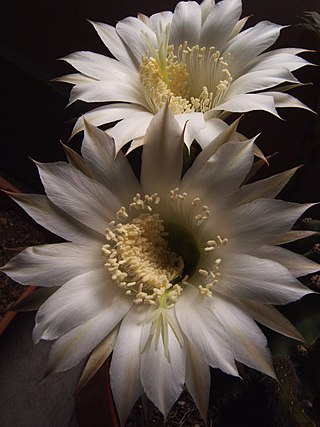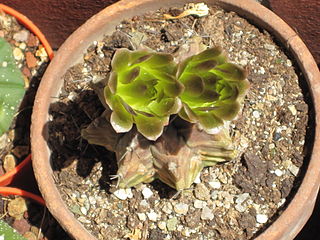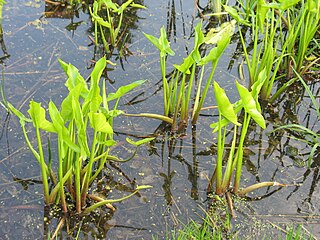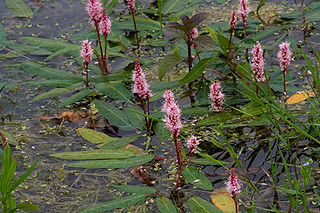
In the fields of horticulture and botany, the term deciduous means "falling off at maturity" and "tending to fall off", in reference to trees and shrubs that seasonally shed leaves, usually in the autumn; to the shedding of petals, after flowering; and to the shedding of ripe fruit. The antonym of deciduous in the botanical sense is evergreen.

Safflower is a highly branched, herbaceous, thistle-like annual plant in the family Asteraceae. It is commercially cultivated for vegetable oil extracted from the seeds and was used by the early Spanish colonies along the Rio Grande as a substitute for saffron. Plants are 30 to 150 cm tall with globular flower heads having yellow, orange, or red flowers. Each branch will usually have from one to five flower heads containing 15 to 20 seeds per head. Safflower is native to arid environments having seasonal rain. It grows a deep taproot which enables it to thrive in such environments.

Salix nigra, the black willow, is a species of willow native to eastern North America, from New Brunswick and southern Ontario west to Minnesota, and south to northern Florida and Texas.

Platystemon is a monotypic genus of flowering plants in the poppy family containing the single species Platystemon californicus, which is known by the common name creamcups. It is native to Oregon, California, Arizona, Utah and Baja California, and is found in open grasslands and sandy soils below 6,000 feet (1,800 m) elevation.

Pyrenophora graminea is the causal agent of barley stripe. Barley stripe is disease of barley that once caused significant crop yield losses in many areas of the world. Its associated anamorph is Drechslera graminea(Rabenhorst ex Schlechtendal) S. Ito 1930.

Hyles lineata, also known as the white-lined sphinx, is a moth of the family Sphingidae. They are sometimes known as a "hummingbird moth" because of their bird-like size and flight patterns.

Heteranthera limosa is an annual flowering plant in the water hyacinth family known by the common names ducksalad and blue mudplantain. It grows in shallow water or on mud. It is considered a threatened species in parts of the central United States, and an invasive species weed in California, where it is a nuisance in rice paddies. It is also occasional in Florida waterways.

Echinopsis oxygona, also known as Eyries cactus, Easter lily cactus or sea-urchin cactus, is a species of flowering plant in the cactus family Cactaceae, native to South Brazil, Uruguay and northern Argentina. Its features include many robust spines, spherical shape, and a large flower, with sharply pointed lavender or white petals, and a fine faint scent.

Erysimum cheiri, syn. Cheiranthus cheiri, the wallflower, is a species of flowering plant in the family Brassicaceae (Cruciferae), native to Greece, but widespread as an introduced species elsewhere. It is also treated as a hybrid under the name Erysimum × cheiri. It is widely cultivated as a garden plant.

Heteranthera is a genus of aquatic plants in the water hyacinth family, Pontederiaceae, known generally as mud plantains. Species of this genus are native to tropical and subtropical America and Africa. They live in the water or in wet soils. They produce leaves on long petioles and some are cultivated for their attractive flowers. Leaves are of two types - linear and submerged or orbicular and floating. Some species have cleistogamic flowers.

The white-faced darter or small whiteface is a dragonfly belonging to the genus Leucorrhinia in the family Libellulidae, characterised by red and black markings and a distinctive white patch on the head. It is found in wetlands and peat bogs from northern Europe eastwards to Siberia, and the adults are active from around April till September, which is known as the "flight period". It breeds in acidic bodies of water, laying its eggs in clumps of sphagnum moss that provide a safe habitat for larval development. The larvae are particularly vulnerable to predation by fish, and so are usually found in lakes where fish are not present. L. dubia is listed as a species of least concern (LC) by the IUCN Red List, however, it is potentially threatened by habitat destruction, pollution, and climate change.

Gymnocalycium mihanovichii is a species of cactus from South America. The most popular cultivars are varied mutants which completely lack chlorophyll, exposing the red, orange, or yellow pigmentation. These mutant strains are often grafted onto the hylocereus cactus, and the combined plant is called a "Moon Cactus". Moon cacti are commonly grown as houseplants and are also known as Ruby Ball, Red Cap, Red Hibotan, or Hibotan cacti.

Myriophyllum verticillatum, the whorl-leaf watermilfoil or whorled water-milfoil, is a native to much of North America, North Africa, and Eurasia. It closely resembles another native milfoil, called northern water milfoil Whorled water milfoil is also easily confused with four types of invasive milfoils: Eurasian water milfoil, Variable water-milfoil, Parrot feather, and hybrid water milfoil.

Peltandra virginica is a plant of the arum family known as green arrow arum and tuckahoe. It is widely distributed in wetlands in the eastern United States, as well as in Quebec, Ontario, and Cuba. It is common in central Florida including the Everglades and along the Gulf Coast. Its rhizomes are tolerant to low oxygen levels found in wetland soils. It can be found elsewhere in North America as an introduced species and often an invasive plant.

Lindernia dubia is a species of flowering plant known by the common names yellowseed false pimpernel and moist bank pimpernel. It is a member of the "new" plant family Linderniaceae, and it is sometimes treated as a member of the families Scrophulariaceae and Plantaginaceae. It is native to much of the Americas from Canada to Chile, and it can be found on other continents as an introduced species. It grows in wet habitat, such as riverbanks, pond margins, and meadows. It is an annual herb growing a mostly erect, branching stem to exceed 30 centimeters in height. The oppositely arranged leaves vary in size and shape, from lance-shaped to oval, toothed or not, and under one to over three centimeters long. Flowers emerge from upper leaf axils. Each has a calyx of five narrow, linear sepals. The tubular corolla is up to a centimeter long, white in color with a blue or purple tint, and lipped at the mouth, the lower lip with three rounded lobes. The fruit is a capsule containing yellow seeds.

Persicaria amphibia is a species of flowering plant in the knotweed family known by several common names, including longroot smartweed, water knotweed, water smartweed, and amphibious bistort. It is native to much of North America, Asia, Europe, and parts of Africa, and it grows elsewhere as an introduced species and sometimes a noxious weed.

Ranunculus flabellaris is a species of flowering plant in the buttercup genus, Ranunculus, known by the common name yellow water buttercup. It is native to much of North America, including the southern half of Canada and most of the United States.

Ventenata dubia is a species of grass known by the common names North Africa grass and wiregrass. It is native to southern Europe, North Africa and the Middle East. It is becoming well known in North America, where it is an introduced species and a noxious weed of cultivated and disturbed habitat. It is problematic in the Pacific Northwest, where it was first identified in Washington in 1952 and Idaho in 1957. It was found in Utah in 1996. It probably spreads when it gets mixed in with grass seed and is transported and inadvertently planted.

Echinocereus viridiflorus is a species of cactus known by the common names nylon hedgehog cactus, green pitaya, and small-flowered hedgehog cactus. It is native to the central and south-central United States and northern Mexico, where it can be found in varied habitat types, including desert scrub, woodlands, dry grasslands, and short-grass prairie.
Delphinium viridescens is a species of flowering plant in the buttercup family known by the common name Wenatchee larkspur. It is endemic to central Washington state in the United States, where it occurs in the Wenatchee Mountains in Chelan and Kittitas Counties.


















